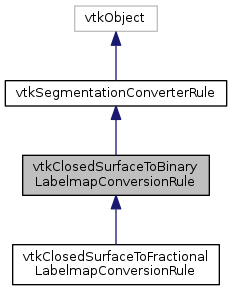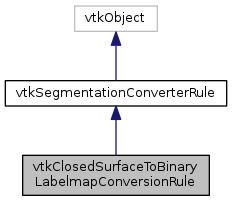Convert closed surface representation (vtkPolyData type) to binary labelmap representation (vtkOrientedImageData type). The conversion algorithm is based on image stencil.
More...
#include <Libs/vtkSegmentationCore/vtkClosedSurfaceToBinaryLabelmapConversionRule.h>
Convert closed surface representation (vtkPolyData type) to binary labelmap representation (vtkOrientedImageData type). The conversion algorithm is based on image stencil.
Definition at line 36 of file vtkClosedSurfaceToBinaryLabelmapConversionRule.h.
◆ Superclass
◆ vtkClosedSurfaceToBinaryLabelmapConversionRule()
| vtkClosedSurfaceToBinaryLabelmapConversionRule::vtkClosedSurfaceToBinaryLabelmapConversionRule |
( |
| ) |
|
|
protected |
◆ ~vtkClosedSurfaceToBinaryLabelmapConversionRule()
| vtkClosedSurfaceToBinaryLabelmapConversionRule::~vtkClosedSurfaceToBinaryLabelmapConversionRule |
( |
| ) |
|
|
protected |
◆ CalculateOutputGeometry()
| bool vtkClosedSurfaceToBinaryLabelmapConversionRule::CalculateOutputGeometry |
( |
vtkPolyData * |
closedSurfacePolyData, |
|
|
vtkOrientedImageData * |
geometryImageData |
|
) |
| |
|
protected |
Calculate actual geometry of the output labelmap volume by verifying that the reference image geometry encompasses the input surface model, and extending it to the proper directions if necessary.
- Parameters
-
| closedSurfacePolyData | Input closed surface poly data to convert |
| geometryImageData | Output dummy image data containing output labelmap geometry |
- Returns
- Success flag indicating sane calculated extents
◆ ConstructRepresentationObjectByClass()
| virtual vtkDataObject* vtkClosedSurfaceToBinaryLabelmapConversionRule::ConstructRepresentationObjectByClass |
( |
std::string |
className | ) |
|
|
virtual |
Constructs representation object from class name for the supported representation classes (typically source and target representation VTK classes, subclasses of vtkDataObject) Note: Need to take ownership of the created object! For example using vtkSmartPointer<vtkDataObject>::Take
Implements vtkSegmentationConverterRule.
Reimplemented in vtkClosedSurfaceToFractionalLabelmapConversionRule.
◆ ConstructRepresentationObjectByRepresentation()
| virtual vtkDataObject* vtkClosedSurfaceToBinaryLabelmapConversionRule::ConstructRepresentationObjectByRepresentation |
( |
std::string |
representationName | ) |
|
|
virtual |
Constructs representation object from representation name for the supported representation classes (typically source and target representation VTK classes, subclasses of vtkDataObject) Note: Need to take ownership of the created object! For example using vtkSmartPointer<vtkDataObject>::Take
Implements vtkSegmentationConverterRule.
Reimplemented in vtkClosedSurfaceToFractionalLabelmapConversionRule.
◆ Convert()
| virtual bool vtkClosedSurfaceToBinaryLabelmapConversionRule::Convert |
( |
vtkDataObject * |
sourceRepresentation, |
|
|
vtkDataObject * |
targetRepresentation |
|
) |
| |
|
virtual |
◆ CreateRuleInstance()
◆ GetClassName()
| virtual const char* vtkClosedSurfaceToBinaryLabelmapConversionRule::GetClassName |
( |
| ) |
|
|
virtual |
◆ GetConversionCost()
| virtual unsigned int vtkClosedSurfaceToBinaryLabelmapConversionRule::GetConversionCost |
( |
vtkDataObject * |
sourceRepresentation = NULL, |
|
|
vtkDataObject * |
targetRepresentation = NULL |
|
) |
| |
|
virtual |
◆ GetCropToReferenceImageGeometryParameterName()
| static const std::string vtkClosedSurfaceToBinaryLabelmapConversionRule::GetCropToReferenceImageGeometryParameterName |
( |
| ) |
|
|
inlinestatic |
◆ GetDefaultImageGeometryStringForPolyData()
| std::string vtkClosedSurfaceToBinaryLabelmapConversionRule::GetDefaultImageGeometryStringForPolyData |
( |
vtkPolyData * |
polyData | ) |
|
|
protected |
Get default image geometry string in case of absence of parameter. The default geometry has identity directions and 1 mm uniform spacing, with origin and extent defined using the argument poly data.
- Parameters
-
| polyData | Poly data defining the origin and extent of the default geometry |
- Returns
- Serialized image geometry for input poly data with identity directions and 1 mm spacing.
◆ GetName()
| virtual const char* vtkClosedSurfaceToBinaryLabelmapConversionRule::GetName |
( |
| ) |
|
|
inlinevirtual |
◆ GetOversamplingFactorParameterName()
| static const std::string vtkClosedSurfaceToBinaryLabelmapConversionRule::GetOversamplingFactorParameterName |
( |
| ) |
|
|
inlinestatic |
Conversion parameter: oversampling factor Determines the oversampling of the reference image geometry. If it's a number, then all segments are oversampled with the same value (value of 1 means no oversampling). If it has the value "A", then automatic oversampling is calculated.
Definition at line 44 of file vtkClosedSurfaceToBinaryLabelmapConversionRule.h.
◆ GetSourceRepresentationName()
| virtual const char* vtkClosedSurfaceToBinaryLabelmapConversionRule::GetSourceRepresentationName |
( |
| ) |
|
|
inlinevirtual |
◆ GetTargetRepresentationName()
| virtual const char* vtkClosedSurfaceToBinaryLabelmapConversionRule::GetTargetRepresentationName |
( |
| ) |
|
|
inlinevirtual |
◆ IsA()
| virtual int vtkClosedSurfaceToBinaryLabelmapConversionRule::IsA |
( |
const char * |
type | ) |
|
|
virtual |
◆ IsTypeOf()
| static int vtkClosedSurfaceToBinaryLabelmapConversionRule::IsTypeOf |
( |
const char * |
type | ) |
|
|
static |
◆ New()
◆ operator=()
◆ SafeDownCast()
◆ SetUseOutputImageDataGeometry()
| virtual void vtkClosedSurfaceToBinaryLabelmapConversionRule::SetUseOutputImageDataGeometry |
( |
bool |
| ) |
|
|
virtual |
◆ UseOutputImageDataGeometry
| bool vtkClosedSurfaceToBinaryLabelmapConversionRule::UseOutputImageDataGeometry |
|
protected |
Flag determining whether to use the geometry of the given output oriented image data as is, or use the conversion parameters and the extent of the input surface. False by default, because pre-calculating the geometry of the output image data is not trivial and should be done only when there is a specific reason to do that (such as doing the conversion for sub-volumes and then stitching them back together).
Definition at line 100 of file vtkClosedSurfaceToBinaryLabelmapConversionRule.h.
The documentation for this class was generated from the following file:


 Public Types inherited from vtkSegmentationConverterRule
Public Types inherited from vtkSegmentationConverterRule Public Member Functions inherited from vtkSegmentationConverterRule
Public Member Functions inherited from vtkSegmentationConverterRule Static Public Member Functions inherited from vtkSegmentationConverterRule
Static Public Member Functions inherited from vtkSegmentationConverterRule Protected Member Functions inherited from vtkSegmentationConverterRule
Protected Member Functions inherited from vtkSegmentationConverterRule Protected Attributes inherited from vtkSegmentationConverterRule
Protected Attributes inherited from vtkSegmentationConverterRule 1.8.14
1.8.14